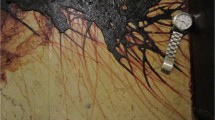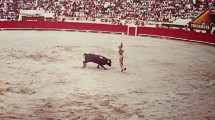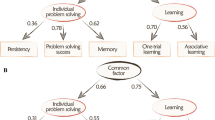Abstract
Animals in the wild often have physical impairments that can affect their fitness. The aim of this study was to compare injuries and impairments of four different primate species (black-and-white colobus, red colobus, red-tailed monkeys, and grey-cheeked mangabeys) living in Kibale National Park (Uganda), and estimate the proportion of injured and impaired individuals among the sexes and age classes. The species differed in the proportion of individuals with injuries and impairments, with 16.7% in black-and-white colobus, 23.1% in red colobus, 16.2% in red-tailed monkey and 30.2% in grey-cheeked mangabeys. Species also differed in the types and location on the body of injuries. Adult animals had more injuries than immatures. Males had more injuries than females, in all but red-tailed monkeys. The results are discussed in relation to the literature on aggressive behavior, locomotion, and predation in these species.
Similar content being viewed by others
References
Albrecht GL, Seelman KD, Bury M (eds) (2001) Handbook of disability studies. SAGE, Thousand Oaks, CA
Arlet ME, Molleman F, Chapman CA (2007) Indications for female mate choice in grey-cheeked mangabeys Lophocebus albigena johnstoni in Kibale National Park, Uganda. Acta Ethol 10:89–95
Arlet ME, Molleman F, Chapman CA (2008) Mating tactics in male grey-cheeked mangabeys (Lophocebus albigena). Ethology. 114:851–862. doi:10.1111/j.1439-0310.2008.01533.x
Bramblett CA (1967) Pathology in the Darajani baboon. Am J Phys Anthropol 26:331–340
Brandwood A, Jayes AS, Alexander RM (1986) Incidence of healed fracture in the skeletons of birds, molluscs and primates. J Zool 208:55–62
Buikstra JE (1975) Healed fractures in Macaca mulatta. Folia Primatol 23:140–158
Bulstrode C, King J, Roper B (1986) What happens to wild animals with broken bones? Lancet 4:29–31
Byrne RW, Stokes EJ (2002) Effects of manual disablity on feeding skills in gorillas and chimpanzees. Int J Primate 23:539–554
Carey JR, Pinter-Wollman N, Wyman M, Müller HG, Molleman F, Zhang N (2007) A search for principles of disability using experimental impairment of Drosophila melanogaster. Exp Geront 42:166–172
Chalmers NR (1968) The social behavior of free living mangabeys in Uganda. Folia Primatol 8:263–281
Chapman CA, Lambert JE (2000) Habitat alteration and the conservation of African primates: a case study of Kibale National Park, Uganda. Am J Primatol 50:169–186
Cords M (1987) Forest guenons and patas monkeys: male–male competition in one male groups. In: Smuts BB, Cheney DL, Seyfarth RM, Wrangham RW, Struhsaker TT (eds) Primate societies. University of Chicago Press, Chicago
Crews DE (2005) Evolutionary perspectives on human longevity and frailty. In: Carey JR et al (eds) Frailty and longevity. Springer, Berlin, pp 57–66
Crockett CM, Pope T (1988) Inferring patterns of aggression from red howler monkey injuries. Am J Primatol 15:289–308
Fox H (1939) Chronic arthritis in wild mammals. Trans Am Philos Soc 31:71–149
Gleeson B (1999) Geographies of disability. Routhledge, UK
Goodall J (1983) Population dynamics in one community of free-ranging chimpanzees. Z Tierpsychol 61:1–60
Harris TR (2001) Behavior of a black and white colobus group during intergroup encounters. AAPA poster and presentation schedule. Am J Phys Anthrop 114[Suppl 32]:abstract 54
Harris TR (2002) Infanticide and subsequent mating behavior in a black and white colobus monkey group.. AAPA poster and presentation schedule. Am J Phys Anthrop 117[Suppl 34]:abstract 22
Harris TR (2006) Between-group contest competition for food in a highly folivorous population of black and white colobus monkeys (Colobus guereza). Behav Ecol Sociobiol 61:317–329
Iwanoto M (1967) Morphological observations on the congenital malforamtion of limbs in the Japanese monkey. Primates 8:247–270
Javois J, Tammaru T (2004) Reproductive decisions are sensitive to cues of life expectancy: the case of a moth. Anim Behav 68:249–255
Jurmain R (1989) Trauma, degenerative disease, and other pathologies among the Gombe chimpanzees. Am J Phys Anthrop 90:229–237
Jurmain R (1997) Skeletal evidence of trauma in African apes, with special reference to the Gombe chimpanzees. Primates 38:1–14
Jurmain R (2000) Degenerative joint disease in African great apes: an evolutionary perspective. J Human Evol 39:185–203
Kano T (1984) Observations of physical abnormalities among the wild bonobos (Pan paniscus) of Wamba, Zaire. Am J Phys Anthropol 63:1–11
Lovell NC (1990) Patterns of injury and illness in great apes: a skeletal analysis. Smithsonian Institute Press, Washington, DC
Lovell NC (1991) An evolutionary framework for assessing illness and injury in non-human primates. Yearb Phys Anthropol 34:117–155
Mackinnon J (1974) The behavior and ecology of wild orang-utans (Pongo pymeaeus). Anim Behav 22:3–74
McConnell EE, Basson PA, de Vos V, Myers BJ, Kuntz RE (1974) A survey of diseases among 100 free-ranging baboons (Papo ursinus) from the Kruger National Park. Onderstepoort J Vet Res 41:97–168
McCullagh P, Nedler J (1989) Generalized linear models. Chapman and Hall, London
McGraw WS, Cooke C, Shultz S (2006) Primate remains from African crowned eagle (Stephanoaetus coronatus) nests in Ivory coast’s Tai forest: implications for primate predation and early hominid taphonomy in South Africa. Am J Phys Anthropol 131:151–165
McMichael AJ (2007) Human frontiers, environments, and disease. Cambridge University Press, Cambridge
Mitani JC, Sanders WJ, Lwanga JS, Windfelder TL (2001) Predatory behavior of crowned hawk-eagles (Stephanoaetus coronatus) in Kibale National Park, Uganda. Behav Ecol Sociobiol 49:187–195
Nakai M (2003) Bone and joint disorders in wild Japanese macaques from Nagano Prefecture, Japan. Int J Primatol 24:179–195
Oates JF (1977) The social life of black-and-white colobus monkey (Colobus guereza). Z Tierpsychol 45:1–60
Olupot W, Waser PM (2001) Correlates of intergroup transfer in male grey-cheeked mangabeys. Int J Primatol 19:169–187
Packer C (1979) Male dominance and reproductive activity in Papio anubis. Anim Behav 27:37–45
Parr H, Butler R (1999) Mind and body spaces: geographies of illness, impairment and disability. Routledge, UK
Randall FE (1944) The skeletal and dental development and variability of the gorilla. Human Biol 16:23–76
Schultz AH (1944) Age changes and variability in gibbons. Am J Phys Anthropol 2:1–129
Schultz AH (1956) The occrence and frequency of pathalogical and teratological conditions of twinning among non-human primates. Primatologia 1:965–1014
Scorupa J (1989) Crowned eagles Stephanoaetus coronatus in rainforests: observation on breeding chronology and diet at a nest in Uganda. Ibis 131:294–298
Stern M, Goldstone R (2005) Red colobus as prey: the leaping habits of five sympatric old world monkeys. Folia Primatol 76:100–112
Struhsaker TT (1975) The red colobus monkey. University of Chicago Press, Chicago
Struhsaker TT, Leakey M (1990) Prey selectivity by crowned hawk-eagles preying on monkeys in the Kibale Forest, Uganda. Behav Ecol Sociobiol 26:435–443
Struhsaker TT, Leyland L (1985) Infanticide in a partilineal society of red colobus monkeys. Z Tierpsychol 69:89–132
Struhsaker TT, Leyland L (1987) Colobines: infanticide by adult males. In: Smuts BB, Cheney DL, Seyfarth RM, Wrangham RW, Struhsaker TT (eds) Primate societies. The University of Chicago Press, Chicago
Turner SE, Gould L, Duffus DA (2005) Maternal behaviour and infant cogenital limb malformation in a free-ranging group of Macaca fuscata on Awaji Island, Japan. Int J Primatol 26:1435–1457
van Valkenburgh B (1988) Incidence of tooth breakage among large, predatory mammals. Am Nat 131:291–300
Waser P (1974) Intergroup interaction in a forest monkey: the mangabey Cercocebus albigena. PhD thesis, Rockefeller University
Watts DP, Mitani JC (2002) Hunting behavior of chimpanzees at Ngogo, Kibale National Park, Uganda. Int J Primatol 23:1–28
Whitten PL, Smith EO (1983) Wounding patterns in stumptail macaques (Macaca arctoides). Am J Primatol 4:358
WHO (2001) International classification of functioning, disability and health. World Health Organization, Geneva
Acknowledgments
We gratefully acknowledge helpful discussion on the manuscript and statistical advice from Colin Chapman, Lynne Isbell, and Mark Grote. Many thanks to Charles Akora, Clovis Kaganzi, Richard Sabiti, Richard Kaseregenyu, Koojo John, and Swaibu Katusebe for their invaluable assistance in the field. We thank Tara Harris, Irumba Peter, and Magano James for assistance with black-and-white colobus monkeys. We thank the Uganda National Council of Science and Technology, Uganda Wildlife Authority, and Makerere University Biological Field Station for permission to conduct the research. The research complies with the current laws of Uganda. This research was supported by NIH and NIA grants PO1 A6022500 and PO1 A608761 (to J.R.C.).
Author information
Authors and Affiliations
Corresponding author
About this article
Cite this article
Arlet, M.E., Carey, J.R. & Molleman, F. Species, age and sex differences in type and frequencies of injuries and impairments among four arboreal primate species in Kibale National Park, Uganda. Primates 50, 65–73 (2009). https://doi.org/10.1007/s10329-008-0119-9
Received:
Accepted:
Published:
Issue Date:
DOI: https://doi.org/10.1007/s10329-008-0119-9




